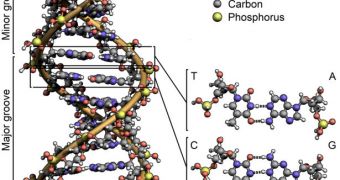Scientists with the Arizona State University (ASU) Biodesign Institute (BI) were recently able to use a technique called DNA origami to create two- and three-dimensional structures very similar to those that can be found in nature.
The capacity to design and built miniature architectural forms at scales no larger than those of viruses is something that microbiologists have been looking to obtain for many years, and for good reason.
They can now construct arbitrary shapes out of DNA, using a technique called DNA origami. What this method allows experts to do is fold the genetic material in a sequence of steps that eventually leads to a predefined shape.
[ADMARK=1This is the same basic principle that is applied to building paper airplanes or boats, the ASU team says. The research effort was led by BI investigators Hao Yan and Yan Liu, who worked closely together with colleagues at the Institute.
Applications for such studies are mind-boggling, the scientists explain. They say that small 3D structures could be used to create nanoscale components for tremendously small computers. Another use would be to construct medical devices, also at the nanoscale, or sentries that roam the body always.
These small probes would get triggered once they meet an invader – such as a bacteria, microbe or other pathogen. Furthermore, the small structures may also carry drugs, that could be delivered right inside cells and tumors, experts add.
Details of the new investigation were published in the April 13 issue of the top journal Science. What the ASU BI method allows for is the construction of nanoscale structures with complex curvatures.
“We are interested in developing a strategy to reproduce nature’s complex shapes. To make curved objects requires moving beyond the approximation of curvature by rectangular pixels,” Yan explains.
“People in the field are interested in this problem. For example, William Shih’s group at Harvard Medical School recently used targeted insertion and deletion of base pairs in selected segments within a 3-D building block to induce the desired curvature,” the expert adds.
“Nevertheless, it remains a daunting task to engineer subtle curvatures on a 3-D surface,” he goes on to say. “Our goal is to develop design principles that will allow researchers to model arbitrary 3-D shapes with control over the degree of surface curvature,” Liu concludes.

 14 DAY TRIAL //
14 DAY TRIAL //